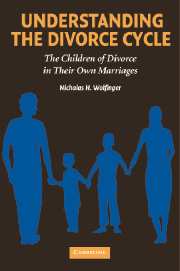Book contents
- Frontmatter
- Contents
- Preface
- Acknowledgments
- 1 Introduction
- 2 Why Divorce Begets Divorce
- 3 Coupling and Uncoupling
- 4 How Strong Is the Divorce Cycle?
- 5 Historical Developments
- 6 The Cohabitation Revolution
- 7 Conclusion
- Appendix A Data and Methods
- Appendix B Evaluating the Role of Marriage Differentials in the Weakening Divorce Cycle
- Notes
- Bibliography
- Index
4 - How Strong Is the Divorce Cycle?
Published online by Cambridge University Press: 27 July 2009
- Frontmatter
- Contents
- Preface
- Acknowledgments
- 1 Introduction
- 2 Why Divorce Begets Divorce
- 3 Coupling and Uncoupling
- 4 How Strong Is the Divorce Cycle?
- 5 Historical Developments
- 6 The Cohabitation Revolution
- 7 Conclusion
- Appendix A Data and Methods
- Appendix B Evaluating the Role of Marriage Differentials in the Weakening Divorce Cycle
- Notes
- Bibliography
- Index
Summary
This chapter addresses the prevalence of the divorce cycle. I will answer the following questions:
How much does parental divorce increase the chances that offspring will end their own marriages?
What demographic characteristics make divorce transmission stronger or weaker?
How does the divorce cycle vary by family type, given the diversity of divorced families?
Do the effects of parental divorce extend to second and third marriages?
Although some of these questions have been addressed by previous research, another look is warranted for various reasons. The first studies of the divorce cycle are now thirty years old. Statistical techniques have evolved considerably since then, as have data resources. The divorce rate is also higher than it was thirty years ago. The two waves of the National Survey of Families and Households (NSFH), administered between 1987 and 1994, contain extensive detail on respondents' family backgrounds and patterns of relationship formation, yet they have been the basis of almost no research on the divorce cycle.
The advantages of modern statistical techniques and precise data become apparent after taking into account the variety of results produced by prior research. Although all studies confirm that parental divorce increases the likelihood of offspring divorce, there has been little agreement about the strength of the relationship. Another problem has been measures of family structure that lump together various forms of nonintact parenting, making it hard to assess the precise impact of parental divorce on marital stability.
- Type
- Chapter
- Information
- Understanding the Divorce CycleThe Children of Divorce in their Own Marriages, pp. 53 - 75Publisher: Cambridge University PressPrint publication year: 2005



